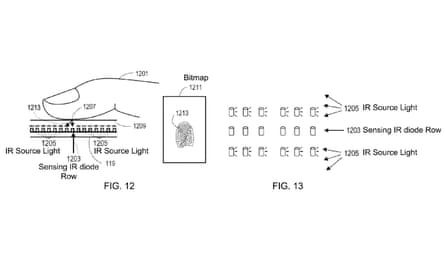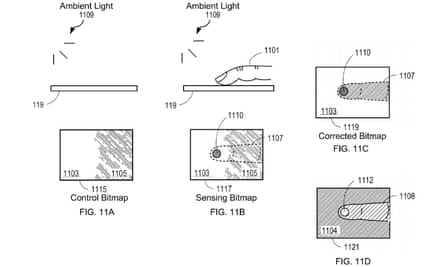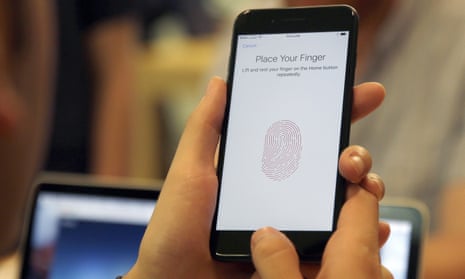Apple is working on fitting fingerprint scanners beneath the screen of its iPhone, removing the need for a separate home button, a newly published patent has revealed.
The patent, purchased by Apple as part of its acquisition of a display company called LuxVue in 2014, details a system of using LEDs mounted underneath a display to both detect finger’s position and scan its surface to be able to read a fingerprint.
Apple said in the newly reassigned patent: “When the fingerprint is placed upon the transparent substrate, the sensing IR diodes within the display panel sense patterned IR light reflected off grooves of the fingerprint surface.
“This patterned IR light is relayed to the output processor as a bitmap where it is processed to determine the fingerprint surface’s unique pattern. Because the display panel can sense IR light, the display panel is able to perform surface profile determination when the display panel is not emitting visible light.”
The LuxVue-developed technology concentrates on using tiny LEDs under the display to replicate the ability to detect the presence of a finger or other interacting element against the glass of a screen. The majority of mobile devices use capacitive touchscreen layers, which detect a change in capacitance when a finger or other conductive element touches the screen. The technology is also used in many fingerprint sensors and other devices, but has drawbacks particularly in cold weather – they do not work very well when a finger is covered in a glove unless that glove has conductive surface.

The patent describes the use of the array of LED sensors under the display to replicate the functions of both a traditional capacitive touchscreen and a fingerprint scanner, replicating the function of Apple’s Touch ID home button.
Apple states: “The ability to detect an object’s surface profile while the display panel is not emitting visible light enables the display panel to detect a user’s fingerprint to unlock a mobile device such as a cellphone when the display panel appears to be off.
“Accordingly, the display panel need not emit visible light to detect a surface profile of an object, nor does the display panel require a separate sensor to detect the surface profile of an object.”
Apple is not the only company working on new technologies to allow components necessary to the function of a modern smartphone to be moved under the display. Sensors such as ambient light detectors, which provide information to adjust the display’s brightness in line with current light levels, presence sensors that turn off the screen when you put the phone to your ear, the earpiece speaker and the selfie camera are all currently mounted above or around the screen in separate panels.
The placement of those components is one of the biggest hurdles standing in the way of all-screen smartphones, where the unnecessary bezels around the screen are removed in favour of a display that reaches to the very edges and top and bottom of the phone.
Progress is being made to reduce the need for bezels around the display. Some smartphone manufacturers, including Huawei, Google and LG have moved the fingerprint scanner to the back of the device. LG’s latest Android Wear smartwatches have a new ambient light sensor that can operate from beneath a screen, while Sharp and Xiaomi have both released smartphones that use bone-conduction systems built into the screens to remove the need for a separate earpiece speaker at the top of the device.

At the same time, Apple’s iPhones have continued to have large symmetrical bezels at the top and bottom of the their screens, with the home button and integrated Touch ID fingerprint scanner mounted within the bottom bezel and the speaker grille, sensors and selfie camera in the top bezel. These large bezels have made the body of company’s smartphones relatively large compared to competitors, despite having smaller display areas.
Samsung’s highly anticipated Galaxy S8 smartphone is expected to have an edge-to-edge “infinity display” with thin top and bottom bezels that do not even have room for the company’s logo. It should give the Galaxy S8 one of the highest screen-to-body ratios of any smartphone, but even then it will not be truly all-screen.
